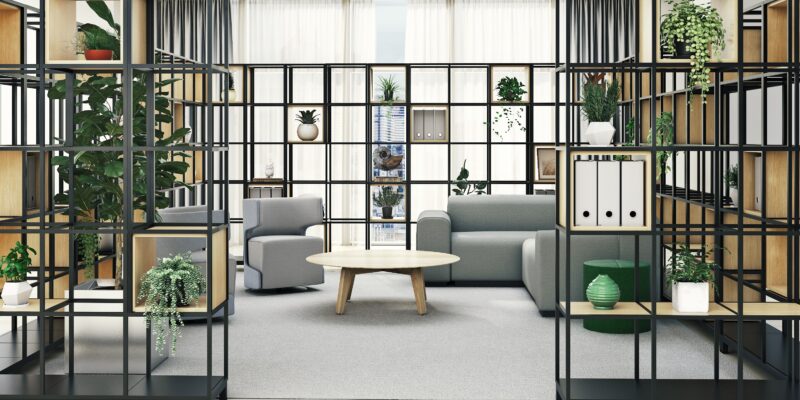
The design of workspace office interiors plays a crucial role in boosting employee engagement and retention. Workspace office interiors play a surprising role in boosting employee engagement and retention. It’s more than just a place to house desks and computers. A well-designed office can significantly impact how employees feel, work, and connect with their colleagues and company culture. Here’s how:
- Creating a Positive Environment: A well-designed office space can create a positive work environment that fosters creativity, collaboration, and productivity. Bright, airy spaces with comfortable furniture and thoughtful layouts can improve mood and morale, leading to higher levels of engagement among employees.
- Reflecting Company Culture: Office interiors can reflect and reinforce a company’s values and culture. By incorporating elements such as brand colors, logos, and mission statements into the design, employees feel a sense of belonging and alignment with the organization’s goals, which can increase their commitment and loyalty.
- Supporting Collaboration and Communication: Open-plan layouts, communal areas, and designated collaboration zones encourage interaction and communication among team members. When employees have opportunities to connect and collaborate easily, they feel more engaged with their work and develop stronger relationships with their colleagues.
- Providing Comfort and Wellness: Employee well-being is increasingly recognized as a crucial factor in engagement and retention. Ergonomic furniture, natural lighting, indoor plants, and amenities like quiet rooms or wellness spaces contribute to a healthier and more comfortable work environment. When employees feel physically and mentally well at work, they are more likely to be engaged and satisfied in their roles.
- Offering Flexibility and Choice: Flexible workspaces that accommodate different work styles and preferences empower employees to choose where and how they work best. Whether it’s a quiet area for focused tasks, a collaborative space for brainstorming sessions, or a cozy lounge for informal meetings, providing options promotes autonomy and increases satisfaction.
- Promoting Learning and Development: Incorporating spaces for learning, training, and professional development demonstrates a company’s commitment to employee growth and career advancement. Whether it’s a dedicated training room, a library of resources, or access to online learning platforms, these amenities signal to employees that their personal and professional development is valued, which can increase engagement and retention.
- Celebrating Success and Recognition: Office interiors can also serve as a platform for celebrating achievements, milestones, and employee recognition. Displaying awards, accolades, and employee accomplishments in common areas reinforces a culture of appreciation and motivates employees to strive for excellence.
Enhanced Well-being and Productivity:
Ergonomics and Comfort: Proper furniture like adjustable desks and comfortable seating reduces physical strain and fatigue, leading to better focus and higher productivity.
Natural Light and Air Quality: Ample natural light and good ventilation improve mood, alertness, and overall well-being, leading to a more engaged workforce.
Biophilic Design: Incorporating elements of nature like plants and natural materials can reduce stress, improve creativity, and generate a sense of calm, fostering a more positive work environment.
Fostering Collaboration and Communication:
Open Floor Plans and Collaborative Spaces: Strategic use of open floor plans and designated collaboration areas encourages interaction and teamwork, leading to better communication and problem-solving.
Meeting Rooms and Quiet Spaces: A variety of meeting spaces allows for brainstorming sessions, presentations, and focused teamwork, while quiet areas offer privacy for focused work or phone calls.
Reflecting Company Culture and Values:
Branding and Aesthetics: The overall design aesthetic, including colors, furniture, and artwork, can reflect the company’s brand and values. This creates a sense of identity and belonging for employees.
Employee Choice and Control: Offering employees some level of control over their workspace personalization, through adjustable lighting or designated relaxation areas, demonstrates trust and fosters a sense of ownership, leading to higher engagement.
Here are some additional factors to consider:
Variety and Flexibility: Providing a variety of work settings allows employees to choose the space that best suits their task, promoting comfort and focus.
Technology Integration: Ensuring seamless integration of technology throughout the workspace allows for efficient communication and collaboration, keeping employees engaged.
By investing in thoughtful workspace design, companies can create an environment that not only improves employee well-being and productivity but also fosters a sense of belonging and connection to the company culture. This can lead to higher employee engagement and ultimately, better retention rates.
In summary, thoughtfully designed workspace office interiors contribute to employee engagement and retention by creating a positive, supportive, and inspiring environment where employees feel valued, connected, and empowered to perform at their best.










